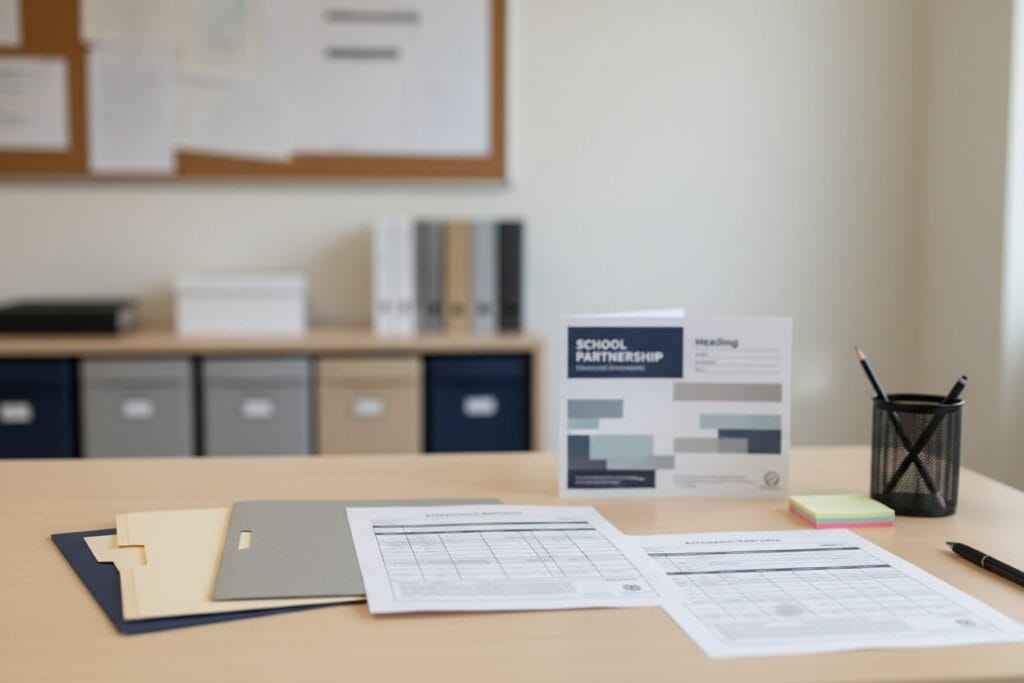A neutral school administrative setting: counselor desk with folders, attendance reports, and a school partnership brochure. No students, no identifiable imagery.
Schools and community organizations don’t partner with treatment programs because of marketing, activity lists, or glossy materials. They partner when a program consistently helps them solve problems they cannot fix internally.
To earn referrals from schools, you must understand how they make decisions, what creates friction for them, and how to position yourself as a reliable resource—not an outsider trying to “sell” them something.
Schools Aren’t Looking for “Programs”—They’re Looking for Support
School counselors, administrators, and community organizations handle constant pressure: attendance issues, behavioral challenges, academic struggles, family instability, crisis support, and resource gaps. They’re not comparing treatment programs—they’re trying to find the fastest, safest way to help a struggling student.
Schools partner with programs that reduce their workload, clarify next steps, and help stabilize the student—not complicate the process.
If you want a deeper understanding of why traditional outreach fails, start with:
Why Admissions Are Down.

What Schools and Community Organizations Evaluate First
The criteria schools and local agencies use is far more practical than most programs expect.
1. Clarity of Population Served
Schools want to know exactly:
- who you serve
- who you don’t serve
- what issues your program handles well
- what situations require a different level of care
If your message is vague, they won’t attempt a referral.
2. Response Speed
Schools move fast. If a counselor calls your admissions team, they expect:
- someone to answer (or return the call quickly)
- a direct, concise explanation of next steps
- clear information they can immediately relay to a parent
Slow replies destroy school partnerships before they start.
3. Ease of Referral
Schools want a simple, predictable referral process. They evaluate:
- how easy it is to contact admissions
- whether your team explains next steps clearly
- how fast a student can be screened
- how well you coordinate communication with parents
Schools trust the program that makes the referral process feel effortless.
If your admissions process is inconsistent, read:
Admissions Conversion: Fixing Inquiry → Enrollment.
4. Communication Style
Schools want factual, calm, professional communication—not:
- emotional language
- vague explanations
- clinical jargon
- marketing claims
They need quick, actionable information they can repeat accurately.
5. Family Experience After Referral
Schools judge your program heavily on how the family describes their enrollment experience. They quietly track whether:
- the family feels supported
- admissions communicated clearly
- the program appeared stable and organized
- the transition was smooth
One negative family experience can stop future referrals.
How School Referral Pathways Typically Work
Not all schools have formal processes, but the general pattern is consistent across districts.
1. Detection of Concern
The school identifies a pattern:
- attendance drops
- behavioral issues
- declining academic performance
- family instability or crisis
2. Internal Review
Counselors or administrative teams evaluate resources already attempted:
- in-school counseling
- mentorship
- academic support
- community programs
3. Outreach to a Treatment Provider
If they cannot solve the problem internally, they contact:
- a known program
- a trusted resource recommended by a colleague
- a program that previously handled cases well
4. Family Communication & Decision
Schools rely on you to provide a clean, simple explanation the parent can understand without confusion.
5. Placement & Follow-Up
The school expects occasional updates and a respectful, professional partnership.
Why School Referrals Stop
Schools rarely give feedback when they stop referring—they simply move to another provider. The most common reasons include:
- slow or unclear communication
- families reporting poor enrollment experiences
- admissions team instability
- mixed messaging about who you serve
- overly complicated referral steps
For concerns related to reputation or public perception, see:
Reputation Repair for Treatment Programs.
Schools stop referring not because of a single incident, but because the partnership feels unpredictable.
How to Build Reliable School & Community Partnerships
1. Be faster and clearer than every other provider
Speed and clarity build more trust than marketing ever will.
2. Make the referral process simple
One phone call. One clear explanation. One predictable path.
3. Coordinate parent communication smoothly
Schools judge your program by how the family describes their experience.
4. Maintain stable systems and staffing
Schools need predictable partners—instability is a deal-breaker.
Schools Want Help, Not Hype
Schools choose programs that solve real problems quickly, communicate cleanly, and guide families with professionalism and calm. If your systems are strong, school partnerships flourish naturally.
Request a School Partnership Readiness Review
Related reading:
How Educational Consultants Choose Programs
Working With Juvenile Courts & Probation
How Tribal Nations Select Youth Treatment Providers
Community & School Partnerships for Youth Programs












